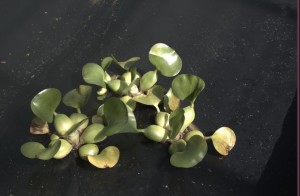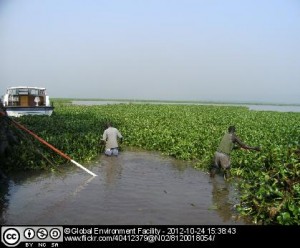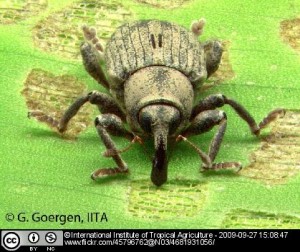Eichhornia crassipes (Water Hyacinth) has a relatively ambivalent place in freshwater habitats. It has become a serious invasive species in many countries, and is one of the world’s most noxious aquatic weeds (Patel, 2012), yet it has been found to have many important uses including the treatment of wastewater and the production of biogas, and is also widely cultivated as an aquatic ornamental plant. It has therefore understandably received a great deal of attention for both the magnitude of the problems it has caused and the promise it holds.
What are E. crassipes relatives?
E. crassipes is a member of the Pontederiaceae family, which is a relatively small family containing 9 genera and 33 species of freshwater aquatics or marsh plants, which are widespread in mainly tropical and subtropical regions. Members of the family are often dominant within their habitat and can become invasive, (Heywood et al., 2007) for example another member of the family, Pontederia cordata or ‘Pickerel weed’.
The genus Eichhornia has just 6 species (The Plant List, 2010) of rhizomatous, floating or submerged, aquatic perennials from waterways in subtropical and tropical South America. E. crassipes is a free-floating example, which grows in a variety of freshwater habitats from shallow ponds and marshes to large lakes, reservoirs and rivers (Gopal, 1987). It is by far the most famous species in the genus, originally for its great beauty but this was quite quickly taken over by its renowned ability to swamp entire waterways.
The good, the bad and the not so ugly… how to identify E. crassipes:
The free-floating plant body comprises of characteristics typical of the family – indeterminate vegetative, leafy stems with leaves bearing large petioles, which appear to be in a rosette, a terminal inflorescence and numerous roots hanging in the water (Heywood et al., 2007). More specifically:
The shoot comprises of a branched rhizome, which can get to about 6cm in diameter and 30cm in length (Gopal, 1987), these bear the leaves, flower parts and roots. They also produce purple stolons (runners), eventually forming daughter plants.
Leaves are broad, thick, highly glossy, and ovoid in shape, usually about 10 – 20cm across (Gopal, 1987). They appear to be arranged in a rosette but are actually distichous (on opposite rows on each side of the stem). Petioles are erect, spongy and either elongated (up to 50cm), swollen in the middle and tapering towards the blade; or form a spongy, bulbous float up to 5cm in diameter (crassipes means thick-stalked, Gledhill, 2008), this is one of the plant’s most distinctive features, allowing it to float on the water (Duke, 1983). Petioles sheath at the base and have a large membranous stipule, which forms a sheath around the next young leaf (Gopal, 1983).
The deep purple roots have a fine, feathery appearance. The root system is extensive and accounts for up to 50% of the plant’s weight. When the water is nutrient rich, roots will be shorter and petioles longer, whereas in nutrient poor waters petioles are shorter and roots are longer (Duke, 1983).
Flowers are pale lilac coloured, borne on a long spike with two bracts at the base. Each spike has 4 – 25 stalkless, hyacinth-like flowers, which are short-lived. The flowers have a 1.5cm tube with a green base and pale top. At the top of this are six showy petal-like tepals, which are ovate to oblong, thin, lilac and up to 4cm long. The top tepal has a central bright yellow diamond shaped area surrounded by a deep blue border and bright red radiating lines. There are 6 lilac stamens, 3 short and 3 long, with violet anthers emerging from the centre (Gopal, 1987).
Plants can vary in size from a few inches to over three feet in height (Duke, 1983).
Origins and current distribution:
Although native to the Amazon basin in tropical South America, E. crassipes has spread throughout the world with the help of man and is widely introduced in North America, Asia, Australia, Africa and New Zealand. (www.issg.org)
Invasiveness:
After its discovery in the early 19th century E. crassipes was widely grown in botanic gardens around the world for its great beauty. However it soon escaped into open water bodies and within a few years the development of excessively large populations, in areas outside its native range where it had no natural enemies, caused serious economic and environmental problems. Today E. crassipes grows on the water surface in over 50 countries in warmer parts of the world (Patel, 2012).
E. crassipes reproduces both vegetatively and sexually, but the vegetative reproduction is responsible for the plant’s rapid spread and colonisation of water bodies. It occurs through the formation of stolons, which produce daughter plants. This is generally very rapid if the temperature is high and nutrients are available, it often invades bodies of water that have been impacted by human activities as they often receive large amounts of nutrients. One plant can multiply to cover one acre in a single growing season forming a dense monospecific strand. So with the combination of its free-floating habit, rapid vegetative propagation, and ability to survive on mud during periods of low water levels, E. crassipes has been able to naturalise in a wide variety of aquatic habitats. It can grow so thick, strong and dense that in some cases people can walk over it and the thick mat can be difficult for even ships to break (Patel, 2012).
This rapid invasion has had a number of economic and environmental impacts. E. crassipes can affect water resources: obstructing navigation routes, and water-flow, which can cause flooding; degrading water quality for domestic and recreational use and causing problems for hydroelectric power generation (Gopal, 1987).
Freshwater environments are also affected as Water Hyacinth lowers the temperature and pH, dissolves oxygen content, and increases carbon dioxide content in water. The oxygen depletion often kills fish, lowers the natural ability of the water body to absorb pollution, and creates septic and odorous conditions. The thick cover blocks sunlight from reaching native aquatic plants some of which support waterfowl (Duke, 1983).
In agriculture, E. crassipes is a common weed in paddy fields and interferes with irrigation and crop growth causing heavy economical losses in many Asian countries. The plants also carry pathogens, which infect several other crops (Patel, 2012).
Finally, human health is affected as the plants provide a habitat and food for several vectors of diseases like mosquitoes and a species of snail known to host a parasitic flatworm which causes schistosomiasis (snail fever) (Duke, 1983).
Control methods:
E. crassipes is controlled in a number of ways: Herbicides have been used to control the plants for many years, this is particularly affective when infestations are small. It does however mean that there may be a health risk if people collect water for drinking and washing from the affected area. This is also expensive on a large scale. Land and water based machines can be used to remove the plants. This is generally seen as the best short-term solution. (Gopal, 1987) It is also very expensive though. Biological controls are a cheaper alternative, two species of weevil known to feed on water hyacinth were introduced in the 1970s firstly to the USA (Calvert, 2007).
More recently a small plant hopper, which specifically feeds on water hyacinth was released also in the USA (Patel, 2012). Leaves are killed by salt water, and this has been used to kill some of it by floating rafts of the cut weed to the sea. Also as the plants favour excessive nutrients, controlling nutrient levels along with other control methods can improve results (Calvert, 2007).
E. crassipes’s many uses:
Although a lot of time and money has been invested in trying to destroy E. crassipes, it has been found to also have many possible uses, which are now recognised as very valuable. Harvesting them for industrial use serves also as a means of environmental control and reduces other control expenditure so has become part of the management strategy. In Agriculture and horticulture, E. crassipes can be used as a mulch or compost, or as animal feed for cattle and pigs as it has high water and nutrient content. In Bangladesh, farmers dry out the plants for use as fuel and then use the ashes as fertiliser (Ojeifo et al. 2002).
E. crassipes is also used in the control of water pollution and wastewater treatment. Conventional treatments for water pollution are very expensive. Water hyacinths are a very suitable alternative as they can absorb significant amounts of pollutants, nutrients and elements through their roots and plant surface (Patel, 2012).
The plants biomass can be used as a fuel as it has a high rate of development and therefore holds a large amount of energy. The gasification of this biomass provides a clean and efficient fuel (biogas), which is a mix of methane and carbon dioxide produced by anaerobic degradation of organic matter by specialised bacteria. 1 hectare of E. crassipes can produce over 70,000m cubed of biogas (Calvert, 2007). Use of dried water hyacinth as fuel is also common in rural areas of Asia.
Parts of the plant are also used in the production of traditional handicrafts in the Philippines, Thailand and Vietnam. The water hyacinth’s dried stems are woven together to form a braid or cord used for making bags, footwear, baskets, furniture and other decorative items. Water hyacinth fibres are also used to make paper (Calvert, 2002).
Cultivation:
E. crassipes is widely grown as an aquatic ornamental along with other plants in Pontederiaceae like Pontederia cordata. They can cause problems in man made ponds if uncontrolled, but can also provide a source of food for fish, keep water clean and help to provide oxygen.
Plants grow a lot in summer and rainy seasons, and growth declines with the onset of winter, when leaves are killed at very low temperatures and by frost. Therefore it behaves as an annual in sub temperate regions.
Water Hyacinth can be grown in a greenhouse pool, tropical aquarium, or outdoors in a decorative pool. In frost-prone areas, it should be over wintered under glass, where it should be kept on trays of moist, loamless compost at a minimum of 15 degrees C in full light. Aquarium plants need 30 – 40cm of head space to grow well. Outdoors, grow Water Hyacinths on open water in full sun. In frost prone areas introduce plants onto the water surface when the danger of frost has passed. To propagate, detach offshoots at any time of year (Brickell, 2008).
Common names:
Given the worldwide distribution of the species, it is no surprise that there are many vernacular names given to E. crassipes in different countries, a few examples are: Antigua – Water Violet, Bangladesh – Kochuripana, Brazil – Aguapes, Dominican Republic – Lila de Agua, Assam – Meteka, USA – River raft, and in Sinhala they are known as Japan Jabara as they were used in World War II to fool Japanese pilots into thinking lakes were fields where they could land their aircraft, leading to crashes (Gopal, 1987).
References:
Brickell, C. (2008). The A-Z Encyclopaedia of Garden Plants (A-J), The Royal Horticultural Society. London, Great Britain, Dorling Kindersley
Calvert, P. (2002). Website: http://practicalaction.org/water-hyacinth Accessed 05/12/2012
Duke, J., (1983) Eichhornia crassipes, in Handbook of Energy Crops. Available online: http://www.hort.purdue.edu/newcrop/duke_energy/Eichornia_crassipes.html
Gledhill, D. (2008). The Names of Plants, Fourth Edition. Cambridge University Press.
Global Invasive Species Database. Website: http://www.issg.org/database
Gopal, B. (1987). Water Hyacinth, Aquatic plant studies 1. Elsevier Science publishing company inc, New York.
Heywood, V.H., Brummitt, R.K., Culham, A., & Seberg, O. (2007). Flowering plant families of the world. Ontario, Canada: Firefly Books.
Ojeifo, M., Ekokotu, P.A., Olele, N.F. and Ekelemo, J.K. (2002). A review of the utilisation of Water Hyacinth: Alternative and sustainable control measures for a noxious weed, in: Proceedings of the international conference on Water Hyacinth, 27 Nov – 1 Dec 2000, New Bussa, Nigeria. Published on the internet; website: http://aquaticcommons.org/996/1/WH_071-078.pdf
Patel, S., 2012. Threats, management and envisaged utilisations of aquatic weed Eichhornia crassipes: an overview. Reviews in Environmental Science and Bio/Technology, Volume 11, Issue 3, pp. 249-259
The Plant List (2010). Version 1. Published on the Internet; website: http://www.theplantlist.org/ Accessed 04/12/2012








Pingback: A Visit from Aldryngton Primary School | Tropical Biodiversity
Pingback: The Zebra Danios (Danio rerio) have produced babies | Tropical Biodiversity
its advantages and disaddvantages are equal if properly exploited. but dangerous to fresh water bodies if un checked
This plant also use for medicine I have a formula